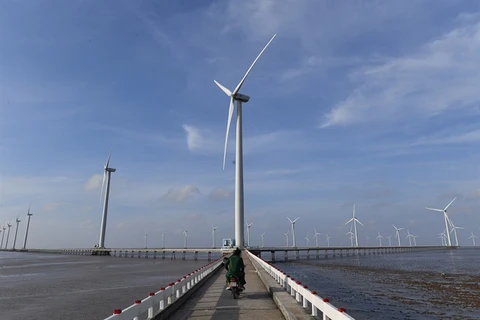 La Gan wind power project is expected to provide electricity for 7 million households (Photo: VietnamPlus)
La Gan wind power project is expected to provide electricity for 7 million households (Photo: VietnamPlus) Hanoi (VNA) – Apart from providing green energy, developing offshore wind power also supports Vietnam in achieving its commitment to net-zero emissions by 2050 that the country made at the 26th United Nations Climate Change Conference of the Parties (COP26), said Danish Ambassador to Vietnam Nicolai Prytz.
|
Addressing a seminar themed “Promoting Vietnam’s offshore wind power development: International practices and policy recommendations” in Hanoi on March 16, the Danish diplomat stressed that developing offshore wind power is a great dual opportunity for Vietnam.
The workshop, co-organised by the Party Central Committee's Economic Commission and the Embassy of Denmark in Vietnam, aimed to create a forum for open dialogue and discussion among Vietnamese ministries and agencies with local and international organisations, experts, and businesses, allowing them to share international experience and propose relevant policies for Vietnam to develop its offshore wind power industry.
Prytz said being one of the strong and long supporters of Vietnam’s transformation to a green and sustainable energy sector, Denmark is looking forward to a clear and consistent regulatory framework, which is essential for the development of the offshore wind industry, starting with the approval of the PDP 8 and exclusive offshore survey rights.
Opportunities and potential for development of offshore wind power
Nguyen Duc Hien, deputy head of the Party Central Committee’s Economic Commission, said that Vietnam holds great potential and advantages for wind energy development.
Offshore wind energy has been evaluated as one of the most effective replacements for fossil fuel energy as the average electricity cost from offshore wind farms has sharply decreased (by approximately 60% in the 2010 – 2021 period), Hien said.
With its capacity and experience of building offshore and marine works as well as supporting logistics systems of the oil and gas industry, Vietnam could make good use of its internal resources to develop the offshore wind power industry in connectin with the value chain of support industries and logistics services in the coming years, Hien said.
The draft National Power Development Plan VIII (PDP 8) sets a target to develop about 16,121MW of onshore and nearshore wind power and about 7,000MW of offshore wind power by 2030. The proportion of wind power in the total capacity of the power system will be about 15.8%, of which offshore wind power represents 4.8%. By 2045, the offshore wind capacity is expected to reach approximately 64,500MW.
According to Hien, by the end of 2021, the total registered capacity of offshore wind power investment in Vietnam had been around 154 GW.
However, because offshore wind power development is a new field, there are still many issues related to planning, investment mechanism, standards and regulations.
He also pointed out the big problems that face the offshore wind power industry in Vietnam including technical and technological complexity, and large and long-term capital.
 Nguyen Duc Hien, deputy head of the Party Central Committee’s Economic Commission (Photo: VietnamPlus)
Nguyen Duc Hien, deputy head of the Party Central Committee’s Economic Commission (Photo: VietnamPlus) International experts highly valued Vietnam's potential for offshore wind development, saying that the country boasts favourable natural conditions with a long coastline, abundant wind source and relatively shallow seabed suitable for the erection of a permanent foundation system.
Perfecting legal framework to attract investment
According to a report on the potential of offshore wind and wave energy in the waters of Vietnam by the General Department of Meteorology and Hydrology under the Ministry of Natural Resources and Environment, the sea areas with the best potential for wind energy are from Binh Dinh to Ninh Thuan, and from Binh Thuan to Ca Mau, in addition to part of the central waters of the Gulf of Tonkin.
Specifically, the wind potential is said to be good to very good in the coastal areas from Ninh Thuan to Ba Ria-Vung Tau, with average wind speeds of 8m-10m/s and an annual average energy density of 600W to over 700W/sq.m.
Mark Hutchinson, Chair of the Global Wind Energy Council (GWEC) Southeast Asia Task Force, said that there are many solutions for Vietnam to achieve the target of 7 GW of offshore wind power by 2030, such as a rapid development mechanism, a bidding mechanism and incentives through pricing.
 Delegates at the seminar “Promoting Vietnam’s offshore wind power development: International practices and policy recommendations” (Photo: VietnamPlus)
Delegates at the seminar “Promoting Vietnam’s offshore wind power development: International practices and policy recommendations” (Photo: VietnamPlus) The building of related policies and mechanisms needs a long roadmap, while the development of offshore wind power projects takes more time, he emphasised, proposing the Vietnamese Government pilot 2-3 GW of offshore wind through mixed finance sources to reduce costs.
Henrik Scheinemann, Co-CEO of Copenhagen Offshore Partners, said that Vietnam should focus on instigating this proven and highly effective renewable energy industry and learn from other markets that have progressed well during their journey in order to deliver an offshore wind industry that is well-suited to the country’s needs and skills.
Vietnam can and will get this industry established. Now is the time to press forward and allow pilot projects to be instigated, a clear regulatory framework to be delivered, and for developers to share learnings to build up the local supply chain and address Vietnam’s growing thirst for green energy, said the CEO./.
























